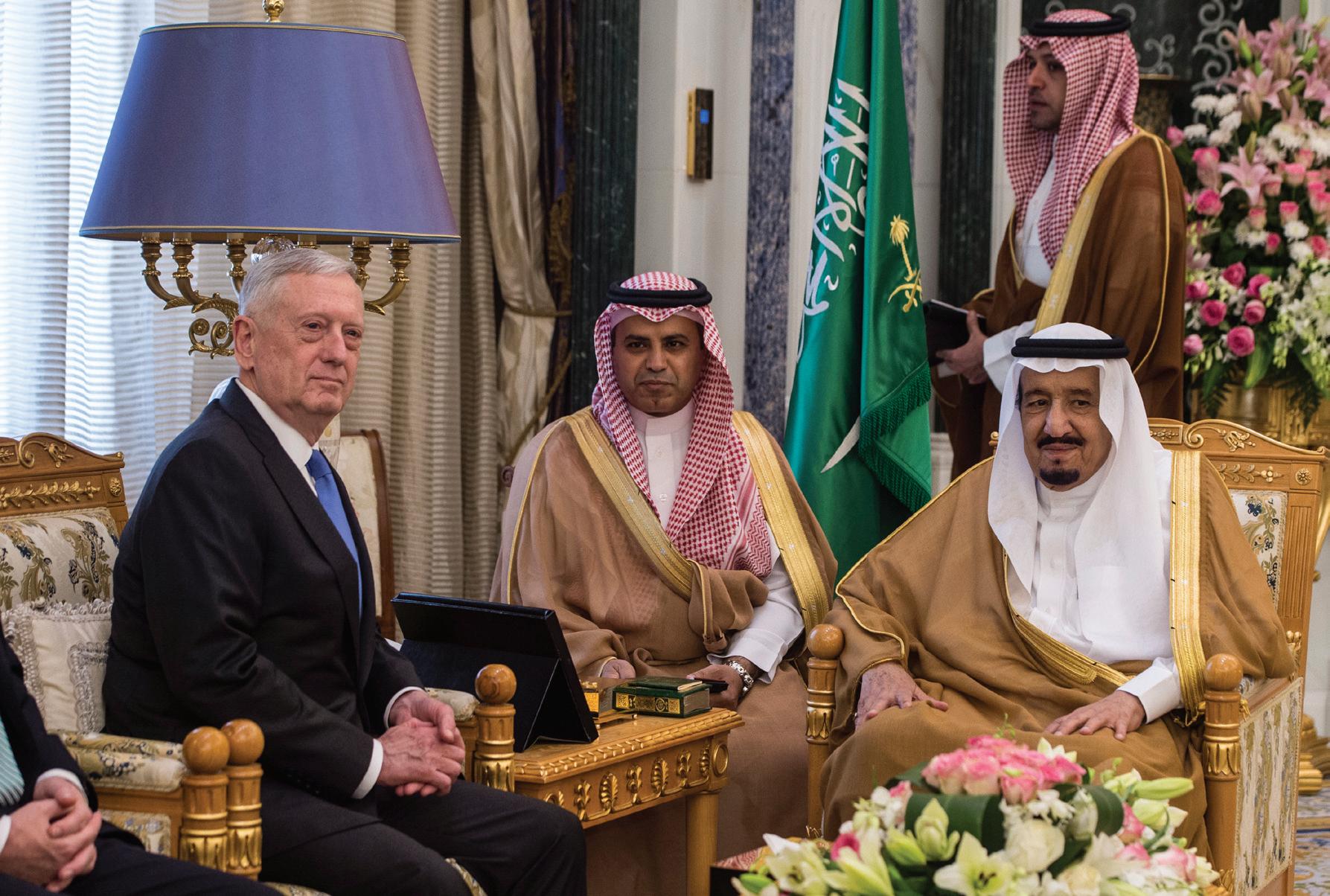
7 minute read
Fundamental Shifts
Gulf Crisis impacts security transitions, holding consequences for Qatar
By Nayef bin Nahar
Advertisement

photo: Jimmy Baikovicius
This paper briefs on the most important security transitions caused by the Gulf crisis and its implications. The paper suggests that there are three fundamental shifts with significant effects on the Gulf security scene: the shift in the security sphere, the shift in the security standards and the shift in the security balance. The shift in security sphere is the transition from regional security to national security. The shift in the security standard is the transition from the customary standard to the legal standard. The shift in the security balance is the transition from the state of dominance represented by Saudi Arabia to competitive situation after the entry of Turkey to the Gulf region. The paper concludes with a reflection on one of the implications of these transformations, which is on the geopolitical weight of the Gulf States and the balance of power.
In terms of the shift in the security sphere, the Gulf Cooperation Council (GCC) came in to existence in the aftermath of the Iran-Iraq war with an aim to create a regional security system that would stand in the face of emerging threats, especially the Iranian challenge. Following the Iran-Iraq war, a new security threat to the GCC countries emerged, namely the Iraqi invasion and the transformation of Iraq from the circle of allies into a circle of enemies and direct threat. This was followed by the threat from armed groups starting with al-Qaeda and then Islamic State in Iraq and Syria.
These security threats were caused by an external source, that is, outside the GCC system. The transfer of the threat from an external source to an internal source caused a radical shift in the security range, bringing down the security scale from the regional level to the national level. Now, the security determinants of the Gulf States are no longer regional, but rather purely national. A threat to a Gulf state may no longer be classified as a threat according to the determinants of another Gulf state. Thus, each country develops its own security vision in isolation from the security threats of other countries. Qatar, for example, doesn’t have a security vision that is harmonized with a regional security vision, but rather it has its own independent vision, because, the security of Qatar cannot be ensured within a larger vision, and an independent vision was needed for this.
This collapse in the concept of regional security of the Gulf region, and the scaling down of security concerns to the national level, forced the Gulf States to redefine the national security constituents for each country, focusing on three determinants: Threats (related to the potential for military escalation), Risks (the prospects that may lead to harm to the state in general), and Challenges.
A unified framework
These three determinants changed radically with the Gulf crisis, firmly establishing the idea of national security at the expense of a unified vision of regional security. The unified vision of regional security is not meant to have an absolute parity among the countries in the security perception, but rather it means a unified framework in which the conceptual differences between the Gulf States may be are melted.
In terms of the shift in the security standard, at a lecture at the Ibn Khaldun Center for Human and Social Sciences in Qatar University, Deputy Prime Minister and Minister of State for Defense H.E. Dr. Khalid Al-Attiyah said that any kind of restoration

US Defense Secretary Jim Mattis meets with Saudi Arabia’s King Salman Bin Abdulaziz Al-Saud in Riyadh April 19, 2017.
photo: Brigitte Brantley
of Gulf relations must be made in accordance with new standards and rules. The rules upon which relations were previously based are no longer valid for the establishment of a new Gulf cooperation. The rules in effect before the Gulf crisis were fundamentally based on the influence of Saudi Arabia, wherein Saudi dominance determined regional security perceptions and concepts to a great extent. This was reflected in Syrian issue where Qatar allowed Saudi Arabia to define the parameters within which Gulf states dealt with the Syrian opposition. The Gulf countries also agreed with the Saudi appreciation of the security threat in the Yemeni context and in the military action taken to handle it.
Today, after the Gulf crisis, the great consideration on which Qatar had woven its security cooperation with Saudi Arabia has faded away. The disintegration of mutual trust made it necessary to find an alternative basis for the establishment of mutual cooperation among the Gulf countries, especially between Qatar and its adversaries, according to the Deputy Prime Minister. Those new rules are based on two fundamental pillars: Non-compliance with what is not a legal obligation; and the adoption of bilateral alliances as a parallel line.
New methodology
The first rule is to abandon the previous methodology of categorizing the threats, risks and security challenges according to the Saudi classification, and to give up all the security consensus arising from the previous moral evaluations of the status of Saudi Arabia, in addition to limiting to a minimum what Qatar needs to do as part of a regional security system that has entitlements in excess of national security entitlements. The second rule reflects the state of loss of confidence that culminated in the aftermath of Gulf crisis because of its comprehensive consequences reaching to all areas replacing the feeling of fraternity with hostility.
In terms of the shift in the security balance from dominance to competition, one of the peculiarities of the Gulf system is that it does have a balance among its members. It is not based on cooperation among states which are neither equal nor even convergent in terms of capabilities and geopolitical weight. The reason for the absence of a minimum balance among the Gulf States goes exclusively to the existence of Saudi Arabia within this system, since it possesses the stable geopolitical capabilities far more than all the other Gulf countries.

The mutuality among the Gulf States is based on hegemony rather than on sheer cooperation. The Kingdom of Saudi Arabia is about 100 times larger in size than Qatar, two thousand times larger than Bahrain, and six times larger than the Sultanate of Oman. In terms of population, Saudi Arabia exceeds Qatar by about thirty seven times. There was no balance in the Gulf security equation, but rather, there was a clear dominance of Saudi Arabia over the region. However, photo: ROC Navy after the Gulf crisis, Qatari-Saudi relations devolved into outright hostility.

US and Saudi Arabian military personnel conduct a practice air assault during Exercise Friendship and Iron Hawk near Tabuk, Saudi Arabia.
photo: Harley Jelis
Thus, the Gulf crisis brought about a substantial change in the security equation, by paving way to the direct presence of the Turkish military in the Gulf territories. This presence led directly to changing the role of Saudi from the dominant actor to a competitor, and the competition naturally tends to be in favor of the Turkish side.
Qatar has resorted to another way of achieving a balance of power, as per international custom, through one or both of 2018, Qatar as part the following methods: self-building and joint building.

A Qatari soldier receives sniper training from a US Soldier in Um Hattah on November 6, 2018, Qatar as part of Exercise Eastern Action 19
photo: James Larimer
Self-building suggests that the state should build a military power parallel to its adversaries, without just relying on coalitions for its security. This model didn’t look impressive for Qatar before the crisis and the withdrawal of ambassadors in 2014, but then it was found that Qatar needs to achieve security self-sufficiency, considering the indicators that predict the possibility of non-integration of the Gulf countries for a collective security.
Joint building can be adopted when the state is unable to achieve a balance of power with its adversary on its own. Then it has to seek the support of other countries to form an alliance. The method of joint military building was the only model that the State of Qatar has explicitly adopted since 1996, it is because of the geopolitical power imbalance between Qatar and its neighbors, in addition to the fact that joint building is less expensive, more flexible and responsive to variables. However, after the Gulf crisis, the situation became different. Although Qatar continued with the method of joint building, at an increased pace and scale, it realized this method could not be adopted as a single option like before, but, rather, as a parallel option to self-building.

The Qatari Emiri Air Force Family Cultural Exchange at Al Udeid Air Base is a partnership-building event.
photo: Phil Speck
About the author
Dr. Nayef bin Nahar is a political science researcher at the Ibn Khaldun Center for Human and Social Sciences at Qatar University.


